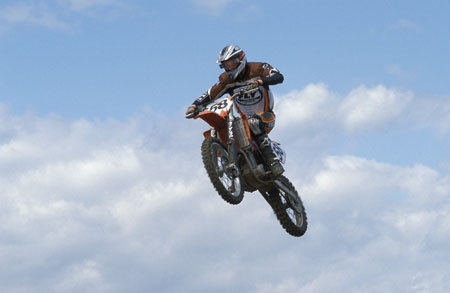As with most sports photography, it is necessary to attend a few meetings, and get a feel for the sport and typical events, before the best images are captured. A very important aspect of motorcross photography is finding the best locations for the type of images required. Images of the start, jumps and sliding turns all require a different approach. It is worth arriving at the track fairly early to scout the possible locations and note where it might be possible to find uncluttered backgrounds free of tents and parked cars. Use the sky or an uncluttered area of track as a background wherever possible.
Another basic consideration is of course the direction of the light. Assuming that the track is outdoors, find locations where the sun is shining on the rider's face and illuminating the side of his machine that will appear in the image. backlighting is effective but much more difficult to use because powerful fill-flash is required to reduce contrast. The use of flash may be prohibited for safety reasons but, even where it is allowed, bear in mind that momentarily blinding a rider could cause an accident.
Although the start of a race is predictable, it is important to get a clear view of the competitors from a distance that allows the frame to be filled with a few riders. Capture the action and atmosphere through congestion, brightly coloured clothing and machines, and plenty of flying dirt. Go in close, really close, and eliminate all the trees and other details that confuse the background. If the pictures lack impact, go in closer!

Jumps are not particularly difficult to photograph once the correct location around the track has been identified. Walk around the areas from which jumps can be seen at fairly close range and watch the riders leaping one after the other. Most follow a similar trajectory. Then find a position from which the rider can be seen approaching the camera, perhaps from a three-quarter angle, almost head-on, or even from one side. A key technique is generally to get down low, or choose a location where the track passes somewhat above the spectators. This allows shots to be taken with the lens angled up, hence eliminating most or all of the background detail and leaving just the sky.
Remember that the direction in which a rider travels through the frame is significant when choosing a shutter speed. A rider approaching the camera can be frozen with a lower shutter speed than one who is travelling across the frame. In general, try to keep shutter speeds up to at least 1/500 second - faster if possible.
Sliding turns often make iconic images because they reveal the speed and atmosphere of the action. Find a location where, with the telephoto lens, it is possible to zoom in on approaching riders with a relatively unobstructed background. Try to capture the bikes banked over at a good angle with plenty of dirt flying from the wheels. The colour of a rider's bike and clothing may also make a difference where they can be chosen to contrast with the background.
Always bear in mind that motocross is a dirty sport. Dust, dirt and mud a thrown everywhere - well, not quite everywhere! It is possible to predict where dirt will be sprayed by the bikes, and it is obviously a good idea to keep photographic equipment away from these areas. Some tracks are sprinkled with water to lay the dust prior to the start of the event. Although this may help to reduce fine dust in the air, it can also turn the track in to mud. Either way, few cameras survive a good dose of flying dirt! Finally, be aware of the direction of the wind when considering where the dust and dirt will fly. Keeping upwind is a good idea if it is practicable. Keep a skylight or UV filter on the lens and be prepared to clean it, carefully, should it become soiled.






